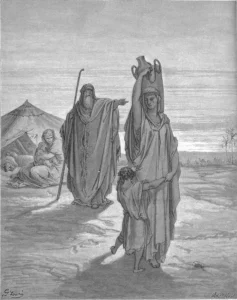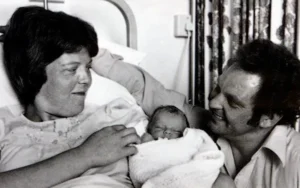From the beginning of the times, from the very dawn of civilization people have dreamed about continuing their bloodline, despite of then incurable infertility to retrieve so longed heirs by all possible means.
The first surrogate mother
 The first known surrogate mother has appeared on the sun-burnt land of Canaan, close to Hebron, 2000 years B.C. Here is what is written about it in the Old Testament (The Book of Genesis, 16), the most sacred book in Judaism, Christianity and Islam.
The first known surrogate mother has appeared on the sun-burnt land of Canaan, close to Hebron, 2000 years B.C. Here is what is written about it in the Old Testament (The Book of Genesis, 16), the most sacred book in Judaism, Christianity and Islam.
“So, Sarah said to Abraham, “The Lord has kept me from having children. Go, sleep with my slave; perhaps I can build a family through her.” Abraham agreed to what Sarah said.” Abraham was 86 years old then, but even his advanced age has not disrupted conceiving.
In 1910 B.C. Hagar gave birth to a son, who was given a name of Ishmael. According to the custom, Sarah has received the boy on her lap as if her own son. He was the child known to be born in a result of so-called traditional surrogate pregnancy.
By the way, The Book of Genesis and Islamic traditions consider Ishmael to be the ancestor of all Arabic people, who are also traditionally called the Ishmaelites or by the name of Ishmael’s surrogate mother – the Hagarian people. It is interesting that 14 years after Ishmael’s birth, in 1897 B.C. (the year when Sodom and Gomorrah were destroyed) Sarah has finally managed to carry a child from her lawful husband, who was at that time preparing to celebrate his 100th birthday, and later safely give a birth to her son Isaac.
The second case of surrogacy
 The second registered case of surrogacy took place in Sumerian Mesopotamia in the middle of the XVIII century B.C. It should be noted that in the kingdom Sumer surrogacy was a widely spread and fully legal practice. The Code of Hammurabi (1792-1750), created in 1780 B.C. and which has, by the way, introduced the presumption of innocence – “innocent until proven guilty”, has stated that a sterile wife willing to have children should give a slave to her husband, wherein a man was only allowed to take “extra” concubines only in case he did not succeed in producing a son. Special “social benefits” were guaranteed for the surrogate mothers who successfully bore a child – even in case of the most defiant behavior they were not allowed “to be sold for silver”.
The second registered case of surrogacy took place in Sumerian Mesopotamia in the middle of the XVIII century B.C. It should be noted that in the kingdom Sumer surrogacy was a widely spread and fully legal practice. The Code of Hammurabi (1792-1750), created in 1780 B.C. and which has, by the way, introduced the presumption of innocence – “innocent until proven guilty”, has stated that a sterile wife willing to have children should give a slave to her husband, wherein a man was only allowed to take “extra” concubines only in case he did not succeed in producing a son. Special “social benefits” were guaranteed for the surrogate mothers who successfully bore a child – even in case of the most defiant behavior they were not allowed “to be sold for silver”.
The names of the rest Sumerian surrogate mothers have not left a trace in history, so the second recorded surrogate mother is considered Bilhah, the handmaid of infertile Rachel, the second favorite wife of Jacob (Abraham’s grandson), who has borne two sons for him – Dan and Naphtali. Jacob himself was then 85 years old.
The third surrogate mother
And the third surrogate mother was Zilpah, the handmaid of the first – and unloved- Jacob’s wife Leah. Through the children Leah has tried to bond Jacob to her who has originally loved her sister Rachel, so she has borne him 4 sons straight. After that she has lost her fertility for a while. Zelpha gave birth to Jacob’s two sons – Gad and Asher. Later the fertile Leah has recovered and gave birth to another two sons – Issahar and Zebulun- and a daughter Dinah. From the legal point of view those children were considered the lawful offspring of the prophets and their wives.
Surrogacy in Egypt
 Surrogacy was a widespread practice in Egypt. Enough to mention that many Egyptian pharaohs have used concubines to produce heirs. The rules of Egypt were considered to be direct descendants of the Sun god Ra. In order not to mix the royal “Sun” blood with the blood of common people, the pharaohs married their own sisters.
Surrogacy was a widespread practice in Egypt. Enough to mention that many Egyptian pharaohs have used concubines to produce heirs. The rules of Egypt were considered to be direct descendants of the Sun god Ra. In order not to mix the royal “Sun” blood with the blood of common people, the pharaohs married their own sisters.
Apparently, the children born in such marriages could not boast of good health, if they survived at all. For instance, Amenhotep I, the pharaoh of the New Kingdom who ruled in XVI B.C. did not have a heir and so he had to refer to the help of a surrogate concubine mother, so that she would give birth to the heir of his bloodline – the future great pharaoh Thutmose I.
On the top of that, although children born from the concubines were accepted as the lawful offspring of the pharaoh, they were quite limited in their rights and could inherit the throne only in case of the absence of the other, more entitled heirs.
Thutmose has ruled for 30 years, has conquered the half of the then known world, has brought thousands of slaves to the Egypt but… was removed from the throne by the demand of the priests when in 1490 B.C. his stepsister and wife – “the sun like” queen Ahmos, the lawful daughter of Amenhotep I, has died.
Pharaoh’s daughter – sixteen years old Hatshepsut- has entered the reign and has become a first ruling queen in the history. She has become a pharaoh even though Thutmose had a son already, also born by a concubine, a future great warrior Thutmose III, the father of Amenhotep III.
Surrogacy in ancient Greece and Rome
Surrogacy has been not less widespread in the ancient Greece and Rome. Plutarch has described a case with a Galatian king (located in the central part of Anatolia) Doiotarus and his infertile spouse Stratonice who has herself picked among the slaves a beautiful concubine called Electra for her royal husband. Stratonice “has raised their children as her own, with love and great generosity”.
Traditional surrogacy, when a surrogate mother is also a biological mother of the child she carries, is still found in some countries where surrogacy is accepted by the law, however, not in Georgia.
Surrogacy in India
There is an interesting Indian legend about how a thousand years later after the events described above, in 599 B.C., as a result of the embryo transplantation a 24th tirthankaras – the last of the Jain Buddha and one of the main characters of the Jain Mahavira mythology (trans. From Sanskrit as “a great hero”)- was born. He was destined to become great and be born accordingly in an aristocratic family of kshatriya (warriors) in which only great people could be born.
 However, Mahavira wished to change his destiny by coming to the world in the family of brahman (priests). He has changed his karma in the life before his new reincarnation and incorporated in a fetus a brahman-woman Devananda was carrying. The gods have learnt about it and the same day Trishala, a wife of a kshatriya became pregnant. On the 82nd day of the pregnancy when both women were sleeping in the arms of their husbands, the gods have extracted the fetuses and changed their places. Now Mahavira was incapable of changing anything and so he had to come to the world in the family of kshatriya decided by the gods and become tirthankaras. Trishala and Devananda who gave birth on the same day have become the first women to gestate somebody else’s children, the first surrogate mothers as we understand it today.
However, Mahavira wished to change his destiny by coming to the world in the family of brahman (priests). He has changed his karma in the life before his new reincarnation and incorporated in a fetus a brahman-woman Devananda was carrying. The gods have learnt about it and the same day Trishala, a wife of a kshatriya became pregnant. On the 82nd day of the pregnancy when both women were sleeping in the arms of their husbands, the gods have extracted the fetuses and changed their places. Now Mahavira was incapable of changing anything and so he had to come to the world in the family of kshatriya decided by the gods and become tirthankaras. Trishala and Devananda who gave birth on the same day have become the first women to gestate somebody else’s children, the first surrogate mothers as we understand it today.
The custom of taking concubines was both known and common in the Medieval Europe as well. For example, Charlemagne (Charles the Great) who has widowed in the year of 800, has taken several concubines. The children born in this marriage were considered unlawful, however this did not prevent them from making a successful career in church: Drogon has become a bishop in Metz and his younger brother Hugo – the abbot of Saint-Quentin. The fact that his father gave them an outstanding at that time education explains a lot.
Cultural and religious differences could not become a barrier for implementing the method of traditional surrogacy in the medieval ages in China, Korea and Japan. One of the cases has left a trace in history and is described in a brilliant picture by Im Kwon Take which is called accordingly “The Surrogate Mother”. The heir to the aristocratic family called Lee, whose wife was infertile, has taken an underage peasant girl for a concubine. By the way, the actress playing the part of the young surrogate mother was awarded by the Venice International for the best female part.
Research in the sphere of artificial insemination
Research in the sphere of artificial insemination has been carried out now for centuries.
 In 1677 A. Leeuwenhoek, the inventor of microscope, has examined the human sperm and has become the first human to see spermatozoons. He has assumed that spermatozoon is a kind of a seed and female womb only creates a fertile environment for it to germinate. In 1790 a famous Scottish surgeon and venereologist John Hunter (1728-1793) has transplanted a man’s sperm into his wife’s vagina using a syringe in order to treat infertility and by doing that carried out a first in the world artificial insemination in the recorded history. As a result, a pregnancy developed, and a healthy child was born.
In 1677 A. Leeuwenhoek, the inventor of microscope, has examined the human sperm and has become the first human to see spermatozoons. He has assumed that spermatozoon is a kind of a seed and female womb only creates a fertile environment for it to germinate. In 1790 a famous Scottish surgeon and venereologist John Hunter (1728-1793) has transplanted a man’s sperm into his wife’s vagina using a syringe in order to treat infertility and by doing that carried out a first in the world artificial insemination in the recorded history. As a result, a pregnancy developed, and a healthy child was born.
In the year of 1880 the first attempt of IVF using lab rabbits and Guinea pigs took place. 11 years later, in 1891 a French researcher Neare has successfully carried out IVF and transplanted an embryo from one rabbit to another by that making her “a first surrogate mother”.
In 1893-97 V.S. Gruzdev (1866-1938) has created a statement about the importance of the egg’s fertility stage for fertilization and for the first time implemented his methods in the tests he had carried out on the rabbits, which later had become a foundation for the IVF (In vitro fertilization) development.
Beginning from the 20-s of the 20th century artificial insemination using husband’s or donor’s sperm has become a wide-spread method of treating infertility.
In 1937 Gregory Goodwin Pincus and Ernst Vinzenz Enzmann from Harvard have reported about successful in vitro fertilization of a rabbit.
The First IVF
The first recorded IVF with a human reproductive material was carried out in 1944 by Harvard gynecologists J. Roch and M. Minkin. They have cultivated a human egg and fertilized it in vitro which has led to creation of a two-cell embryo.
 Despite everything that was done before, the pioneers of the IVF as it is known today are considered world-famous British researches – biologist Robert Edwards and gynecologist Patrick Steptoe.
Despite everything that was done before, the pioneers of the IVF as it is known today are considered world-famous British researches – biologist Robert Edwards and gynecologist Patrick Steptoe.
A human egg was successfully fertilized in vitro for the first time by Edwards in 1967.
The first pregnancy with a “somebody else`s” child (unfortunately turned out to be extrauterine) has occurred in 1976 after the long 9 years of a non-stop research and experiments. On November 10th in 1977 when the amount of misfortunate IVF attempt has reached over 600, the doctors have carried out an eight-cell embryo transplantation which has successfully settled!
The first program of traditional surrogacy
Michigan lawyer Noel Keane who has launched in 1976 a first surrogacy agency in the US is a pioneer in everything that comes to the surrogacy. His first programs were exclusively “traditional”, which means that the egg of the surrogate mother was fertilized in vitro by the sperm of biological father. Thanks to the effort of the energetic lawyer 302 babies were born.
The first coordinated program of the traditional surrogacy in the US – and in the world – was launched in the year 1980 in a collaboration with the doctor Richard M. Levin and the company Surrrogate Parenting Associates, Inc. in Louisville. The procedure of the medical tests and legal negotiations before the launch of the program has taken as long as nine months. However, the pregnancy itself has occurred from the first attempt and resulted in the birth of a healthy boy. After that, with the help of Surrogate Parenting Associates, Inc. more than 500 babies were born, and doctor Levin himself as well as the lawyer Keane have become well-recognized public figures.
The first gestational surrogacy program
The first child born with the program of gestational or full surrogacy, when the surrogate mother gestates the embryo of the biological parents, was born in Ann Arbor (Michigan) in the USA in the April of 1986. The girl was conceived in vitro using the egg and the sperm of the biological parents. The IVF was carried in the Cleveland Medical Center Mount Sinai under the supervision of Dr. Wolf Utian. A 37 years old biological mother has gone through a hysterectomy surgery and she asked her 22-years old friend, who has already safely given birth twice, to carry her child.
The first surrogate program involving relatives was launched in the South Africa in October 1987 when a 48-years old Pat Anthony has successfully gestated and gave birth to her own three grandsons for her 25-years old daughter Karen Ferreira-Jorge. Karen and her 33-years old husband Alcino already had a son but the spouses have dreamt about four children. Karen, who has lost her uterus in 1984 as a result of profusive internal bleeding during the childbirth, thought that her dream would never come true. When she has leant about the surrogacy, the spouses have chosen a potential surrogate mother but had to give up this idea as they worried that she would want to keep the babies. That is when her mother Pat has stepped in.
She has almost insisted that she should do the IVF. Four embryos out of 11 were transplanted to the energetic grandmother and three of them have successfully settled. The childbirth through the Cesarean section was filmed by the British journalists who have payed 500 000 dollars for the exclusive rights on the footage. The babies were called David, Jose and Paula. According to the applicable then in the South Africa law (Child Status Bill) Miss Anthony was considered to be a mother of the triplet, so she had to give up her parental rights in favor of her daughter and son-in-law who had to adopt their own children.

